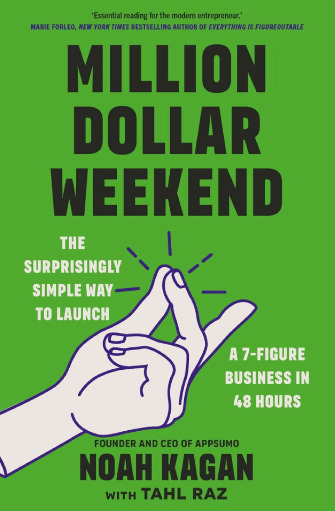#startup guide
Text
0 notes
Text
Book Summary - “Million Dollar Weekend” by Noah Kagan
This book is a guide designed for aspiring entrepreneurs who are looking to jump-start their business ideas into profitable ventures over a short period of time. Kagan, an established entrepreneur known for his role in companies like Facebook and Mint.com, outlines a methodical approach to launching a business quickly and efficiently.
Book Summary
1. Setting the Stage Kagan starts by…

View On WordPress
#actionable steps#Business#business idea validation#business launch#business scalability#business validation#cost-effective marketing#Customer feedback#digital marketing#entrepreneurial journey#Entrepreneurship#financial management#Innovation#marketing#marketing strategies#Million Dollar Weekend#minimum viable product#MVP#Noah Kagan#Problem-Solving#product development#quick business launch#scaling a business#startup guide#Startups
0 notes
Text
Productivity vs. Efficiency: Unleashing the Power of Effective Work Practices
When it comes to evaluating performance in the workplace, the terms "productivity" and "efficiency" are often used interchangeably. However, understanding the distinction between these two concepts is crucial for managers and team members seeking to optimize their operations and achieve sustainable success. By unraveling the differences between productivity and efficiency, businesses can identify the appropriate metrics to gauge their performance accurately.
What is Productivity?
Productivity is a metric that measures the performance of employees, teams, or entire organizations based on the outputs, such as goods or services, produced relative to the inputs, such as time or energy, utilized in the production process. It is a relatively straightforward measure that focuses on quantifying the volume of outputs generated within a given time frame. Many businesses prioritize productivity as it provides a clear indication of work output. Managers often assess productivity by evaluating the number of deliverables completed by an individual team member over a specific number of work hours.
Understanding Efficiency
Efficiency, on the other hand, refers to the ability to produce goods and services with minimal waste. In this context, waste encompasses various aspects, including time, materials, and money. Unlike productivity, which emphasizes the quantity of outputs, efficiency concentrates on the quality of each output. High efficiency entails accomplishing tasks and goals using the fewest possible resources. While efficient workflows may take longer to complete than highly productive workflows, they often yield superior quality results.
Distinguishing Productivity from Efficiency
The fundamental distinction between productivity and efficiency lies in the balance between quantity and quality. Productivity centers on measuring the volume of outputs, whereas efficiency assesses the quality of those outputs. It is important to note that highly productive employees are not necessarily highly efficient. For instance, a salesperson who works 50 hours a week to meet quotas may be productive but not necessarily efficient. On the other hand, a salesperson who works 30 hours a week and consistently meets or exceeds quotas demonstrates efficiency but may not be as productive in terms of output quantity.
To obtain a comprehensive understanding of an individual's performance, it is essential to measure both efficiency and productivity. By calculating each metric separately, organizations can gain valuable insights into the strengths and areas for improvement of their employees and teams.
Calculating Productivity and Efficiency
Productivity revolves around achieving more with less. The true measure of productivity can be determined by dividing the total output by the total input.
Productivity Formula: Total Output ÷ Total Input
For measuring efficiency, managers can calculate the time typically required to complete a project and compare it to the actual time expended by a team member.
Efficiency Formula: Time Typically Required ÷ Time Spent
Traditionally, managers have tracked productivity rates by comparing employee productivity to the hours worked manually. However, with technological advancements, this process can now be automated.
The Importance of Efficiency
While both productivity and efficiency are vital metrics for evaluating employee performance, efficiency holds a greater significance for employers. Efficiency examines the quality of work rather than solely focusing on output quantity. A highly efficient team member can increase productivity while delivering high-quality results. Achieving efficiency requires effective time management, skillful prioritization, and confidence in one's work. Such an employee might complete fewer tasks within a given timeframe compared to a highly productive employee, but the value and impact of those tasks on the company's success would be significantly higher.
Consequently, managers should encourage their team members to prioritize efficiency and quality over merely churning out a high volume of work. By embracing the "work smarter, not harder" ethos, managers can foster a work environment that values efficiency and encourages employees to optimize their output by working intelligently and effectively.
Measuring Productivity and Efficiency
A common misconception is that productivity is the sole indicator of success. However, evaluating work purely based on the number of hours clocked in or tasks completed overlooks the importance of efficiency. To gain a comprehensive understanding of performance, it is essential to consider both metrics.
For example, let's consider a scenario where a team member spends their week creating ten graphic design projects for a client. On the surface, this output may be perceived as highly productive compared to other team members. However, if these projects were rushed due to a focus on productivity rather than efficiency, there is a higher likelihood of client rejection. In contrast, another team member on the same team creates only four designs within the same timeframe, but all of them are accepted by the client with minimal edits. In this case, the team member with the four approved designs has produced more valuable output. It is better to have a smaller number of excellent projects than a larger quantity of subpar ones. This example highlights the importance of efficiency in delivering quality results. By measuring and prioritizing efficiency alongside productivity, managers can ensure that their teams focus on producing valuable and impactful work.
Why Efficiency Matters for Businesses
The phrase "work smarter, not harder" encapsulates the essence of efficiency. Efficient team members can achieve higher productivity while maintaining the quality of their work. They possess skills such as effective time management, the ability to prioritize tasks, and confidence in their abilities. As a result, they can complete tasks that yield the highest returns for the company within a given timeframe.
Efficiency plays a vital role in resource optimization. By minimizing waste, including time, materials, and money, businesses can operate more cost-effectively and enhance their bottom line. Additionally, efficient work practices often lead to improved customer satisfaction, as the focus is on delivering high-quality outcomes that meet or exceed client expectations.
When evaluating productivity and efficiency in the workplace, it is essential to recognize the distinction between quantity and quality. While the quantity of work completed is important, particularly for meeting targets and deadlines, the quality of work should not be overlooked.
Assessing team members solely based on the number of hours worked without considering their efficiency during those hours is an ineffective approach. Instead, managers should prioritize efficiency in project execution and consider the time spent completing tasks. Sometimes, achieving more with less can yield greater results.
In conclusion, by understanding the differences between productivity and efficiency, organizations can develop a holistic approach to measuring performance. While productivity provides insights into output quantity, efficiency is crucial for ensuring output quality. Striving for efficiency and emphasizing the value of work over the sheer volume of tasks completed can lead to higher levels of success and long-term sustainability for businesses.
Remember, it is not about working harder; it is about working smarter and optimizing resources to achieve exceptional results.
Also Read : From Balance to Boundaries: A Fresh Approach to Achieving Work-Life Harmony
#Startup Guide for CEOs in Mumbai#CEOHub Mumbai#CEOs India#CEO productivity#Startup Guide#Effective Work Practices#Productivity vs Efficiency#Importance of Productivity vs Efficiency for CEos
0 notes
Text
Every Cheat you need for The Sims 2 + a userStartup.cheat File
I've just released a tutorial on all the cheats I use for The Sims 2 as well as how to make or install a userStartup.cheat file!
Check Out the Video:
youtube
✨Check Out the Website Post✨
Includes a downloadable copy of my userStartup.cheat file!
#sims 2#the sims 2#ts2#sims 2 cheats#sims 2 tutorial#sims 2 guide#userStartup#User Startup#User Startup Cheat#Sims 2 cheat file#sims 2 video#simtube#simtuber#BellaDovah#YouTube#Youtube
264 notes
·
View notes
Text
watching all of the internet kill itself . they werent lying abt enshittification
#you guys should see what happened to quotev LOL#x. meta. google. tumblr. quotev. deviantart. discord#list goes on those are some of the main ones ive seen#and all of these attempts at indie social media startups suck too. honestly. remember what happened to buzzly . lawl#and cohost is ugly and doesnt work for me. and im not getting some stupid 'bluesky' or . sheezy ? and earlier today#bc i follow artists on insta and meta basically just said 'yeah all of your stuff ever were using it to train ai'#i saw someone mention Yet Another Indie Social Media like . aughhhhhhhhhhhhhhhhhhhhhh#those people are right we gotta just start making our own pages on neocities (<- doesnt know how to code + is exhausted + stupid)#(and i know theres templates and tutorials and guides but i still just get overwhelmed easy)#kinda off topic but i think toyhou.se is genuinely good though. only issue is that its still in beta and to sign up you have to get an#invite code. i dont know how easy it is to get invite codes now but i know when it 1st started up ppl were literally selling invite codes 💀#also other sites that are nice to me are flight rising and pixel cat's end but those + th arent social media sites . wel
11 notes
·
View notes
Photo








@giftober 2022 | Day 31: Free Day. + Day 8: Celebration.
What do we do on our free days? We celebrate and drink! (just kidding, but with this prompt it could be anything + I still needed to fill the prompt for day 8 )
(again thx @xeniawatson and @colourfulwatson for pointing me in the right direction when I needed it )
Bonus:

#giftober2022#martin freeman#john watson#phil rask#Iain MacKelpie#paul worsley#arthur dent#sherlock bbc#bbc sherlock#breeders fx#breedersfx#startup#ode to joy#the hitchhiker's guide to the galaxy#a confession#whiskey tango foxtrot#my gfx
197 notes
·
View notes
Note
WHOS GETTING CLOSER?
They are 😭😭😭😭 they’ve been chasing me since my 5th birthday I’m so tired please help me
#start running soon#starbucks#stardew valley#star wars#i got $50 worth of cleaning products at target for just over $6 – see my money saving strategy#star trek#honkai star rail#tony stark#starfield#ensemble stars#2023: daily star sign guide from mystic meg#open starter#startup#genshin x reader#itto smut#genshin#lifehack#genshin smut#genshin itto#genshin x you#genshin spoilers#itto#gay boy
13 notes
·
View notes
Video
youtube
Join CEO Tamika Peters on this episode of the Grow Your Non-Profit Podcast as she unravels "The Myths of Starting a Nonprofit." Tamika delves into essential topics, including the crucial need for startup capital and the benefits of hiring professionals to set up your nonprofit to avoid costly pitfalls. She discusses the significance of a diverse board matrix, effective budget creation, and developing a strategic plan. Learn how to create and manage an annual activities calendar, covering key aspects such as filing your 990 (nonprofit taxes), organizing fundraising activities, scheduling board meetings, and ensuring compliance with necessary documents. For more click here
#youtube#podcast english#podcast video#nonprofit podcast#fundraising#Tamika Seaton#strategy#nonprofit#nonprofit startups#nonprofit myths#nonprofit fundraising#grow your nonprofit#nonprofits#nonprofit startup#starting a nonprofit#nonprofit organization#nonprofit tips#nonprofit success#nonprofit advice#nonprofit misconceptions#nonprofit management#nonprofit strategy#nonprofit pitfalls#nonprofit startup guide#nonprofit mistakes#nonprofit volunteers#english podcast
2 notes
·
View notes
Text
If you are planning to start your own brand Aeps business as an admin and looking for step by step guide then this is for you.
Here In this blog, I have explained how you can setup your own b2b Aeps admin business with a systematic manner.
These steps will help you to start, run and explore your business seamlessly.
So without skipping a single minute, jump into our informational blog and become AEPS business entrepreneur.
If you want to learn more and need any suggestion, feel free to call at (+91)7230001612 Our Dedicated Support Team.
#aeps business#aeps admin business#aeps b2b business#aeps business startup#fintech business startup#aeps business guide
2 notes
·
View notes
Text
The self is your canvas, painted with experiences and dreams. Embrace your unique mosaic; it defines your essence. 🎨 #SelfDiscovery #InspirationOfDay
#entrepreneur#self improvement#skincare tips#skincare#mindset#self care#self love#mindfulness#black entrepreneurship#merry christmas#marketing#startup#2023: daily star sign guide from mystic meg
3 notes
·
View notes
Text
Understanding User-Centered Design: The Key to Creating B2B Websites That People Love
User-centered design (UCD) stands as a guiding principle, a philosophy that places the user at the heart of the web design process. It's a mindset that recognizes the importance of understanding user needs, behaviors, and expectations to craft websites that not only look stunning but also deliver exceptional user experiences.
If you need your B2B website then get in touch with someone who knows all the basic principles of web design, specifically UCD like B2B web design service providers.
1. Empathy: Stepping into the User's Shoes
Empathy is the cornerstone of user-centered design. It involves understanding the user's perspective, their motivations, frustrations, and goals. To achieve this, designers employ various techniques, including user research, interviews, surveys, and observation.
Empathy in Action:
Understanding User Needs: By conducting user interviews and surveys, designers gain insights into the specific needs and expectations of their target audience. They identify the challenges users face, the tasks they want to accomplish, and the information they seek.
Creating User Personas: Personas are fictional representations of typical users, embodying their characteristics, behaviors, and goals. By creating personas, designers can better understand the diversity of their user base and design for specific user groups.
User Journey Mapping: User journey maps visually depict the steps a user takes to achieve a specific goal on a website. By mapping out these journeys, designers can identify potential pain points and design solutions that streamline the user experience.
2. Iterative Design: A Continuous Process of Refinement
Iterative design is a cyclical process that involves continuous testing, feedback, and refinement. It recognizes that user needs and expectations evolve, and the website must adapt accordingly.
Iterative Design in Action:
Prototyping: Prototypes are early versions of a website or specific features, allowing designers to test concepts and gather user feedback before investing in full-scale development.
Usability Testing: Usability testing involves observing users interacting with the website to identify areas of confusion, frustration, or inefficiency. This feedback is then used to refine the design and improve the user experience.
Data Analytics: Web analytics provide valuable insights into user behavior, revealing how users navigate the website, which features they use most, and where they encounter difficulties. This data informs design decisions and helps optimize the user experience.
3. Clarity and Simplicity: Guiding Users to Their Goals
A user-centered B2B website prioritizes clarity and simplicity, ensuring that users can easily find the information they need and complete tasks without confusion or frustration.
Clarity and Simplicity in Action:
Intuitive Navigation: The website's navigation should be logical and intuitive, allowing users to quickly find the information they need. Clear menus, breadcrumbs, and search functions facilitate easy navigation.
Information Architecture: The information architecture refers to the organization and structure of content on the website. A well-structured information architecture ensures that content is easy to find and understand.
Clear Calls to Action: Calls to action (CTAs) should be clear, concise, and visually prominent, guiding users towards the desired actions, whether it's signing up for a newsletter, downloading a whitepaper, or contacting sales.
4. Personalization: Tailoring Experiences for Individual Users
Personalization involves tailoring the website experience to individual users based on their interests, behaviors, and past interactions. It creates a more relevant and engaging experience for each user.
Personalization in Action:
Content Recommendations: Based on a user's past browsing behavior and interests, the website can recommend relevant content, such as blog posts, case studies, or product information.
Personalized Search Results: Search results can be personalized based on a user's search history and preferences, ensuring that the most relevant results are displayed first.
Tailored Marketing Messages: Based on a user's profile and actions, the website can display personalized marketing messages, such as offering discounts or promoting relevant products or services.
5. Accessibility: Designing for All
Accessibility ensures that the website is usable by everyone, regardless of their abilities or limitations. It's about creating an inclusive experience that caters to a diverse audience.
Accessibility in Action:
Alt Text for Images: Providing alternative text descriptions for images ensures that visually impaired users can understand the content of images using screen readers.
Clear Color Contrast: Using sufficient color contrast between text and background makes it easier for users with visual impairments to read and navigate the website.
Compatibility with Assistive Technologies: The website should be compatible with assistive technologies, such as screen readers and voice control software, allowing users with disabilities to interact with the website effectively.
6. Measuring Success: Data-Driven Insights
Measuring the impact of design decisions is crucial for continuous improvement. Analytics and user feedback provide valuable insights into user behavior and satisfaction.
Measuring Success in Action:
Website Analytics: Web analytics tools track user behavior, revealing how users navigate the website, which pages they visit, and how long they stay. This data helps identify areas for improvement and optimize the user experience.
User Feedback Surveys: Surveys and feedback forms allow users to directly share their thoughts on the website's usability, design, and functionality. This feedback can be used to identify pain points and make targeted improvements.
A/B Testing: A/B testing involves comparing two versions of a webpage or feature to determine which one performs better. This data-driven approach helps optimize conversion rates and improve user engagement.
7. The Rewards of User-Centered Design
Adopting a user-centered approach to B2B web design yields tangible benefits for businesses:
Increased User Engagement and Satisfaction: A user-friendly website keeps users engaged, encourages repeat visits, and fosters positive brand sentiment.
Improved Conversion Rates and Lead Generation: A well-designed website effectively guides users towards desired actions, such as signing up for a newsletter, requesting a demo, or making a purchase.
Enhanced Brand Reputation and Customer Loyalty: A positive user experience strengthens brand perception and builds customer loyalty, leading to long-term business success.
Reduced Support Costs and User Frustration: A user-centered website minimizes user frustration and the need for support, saving businesses time and resources.
User-Centered Design: A Path to Success
By embracing user-centered design, businesses can create B2B websites that not only look great but also deliver exceptional user experiences. This approach leads to increased engagement, improved conversions, and enhanced brand reputation, ultimately driving business growth and success.
#ecommerce#branding#marketing#brand#digitalmarketing#brand new#branddevelopment#entrepreneur#guide#b2b#b2b lead generation#b2bmarketing#b2b services#startup
4 notes
·
View notes
Text
Unlock the Potential of Your New Tech Devices with These Proven Strategies
Introduction
Are you excited about your new tech devices but unsure how to maximize their potential? Look no further! In this comprehensive guide, we will share proven strategies to help you unlock the full capabilities of your new gadgets. Whether you have a new smartphone, tablet, laptop, or any other tech device, these tips will help you make the most out of your investment. Let’s dive in and…
#advancements in artificial intelligence#cybersecurity best practices#emerging tech innovations#future of blockchain technology#guide to cloud computing#how to choose tech solutions for businesses#how to use new tech gadgets#impact of technology on business#Latest technology trends 2024#reviews of the latest tech products#tech tips and tutorials.#technology for smart homes#technology in healthcare#top technology startups#trends in mobile technology
0 notes
Text
Top Tech Startups News 2024: A Comprehensive Guide
In 2024, the tech landscape is bustling with innovative startups that are reshaping the industry. The latest “Top Tech Startups News” showcases an array of groundbreaking companies pushing the boundaries of technology. This article provides a detailed guide to the most exciting tech startups of the year, offering insights into their innovations, market impact, and future prospects.
Table of…
0 notes
Text
0 notes
Text
#forklift#heavy haul trucking#repair#startup#training#truck repair#truck#teaching#forklift operator#guide#united kingdom#london#accident#prevention
0 notes
Text
Power of Emotional Facebook Ads----A Comprehensive Guide
0 notes